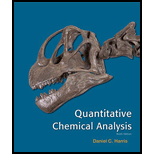
(a)
Interpretation:
The volume of
Ion-Exchange Chromatography:
Ion-Exchange Chromatography is separation technique, which is work in the principle of exchanging of ions based on attraction to the ion exchanger.
It contains two phases, one is stationary phase and another one is mobile phase.
In generally resins are act as a stationary phase, the positively charged ion exchangers attract solute anions and negatively charged ion exchangers are attract solute cations.
The higher polar eluent is passed through a column the exchangers are releases the solute and they will come out from the column.
In this process, the stationary phase (ion exchangers) is exchange the solute ions into eluent ions therefore it is called as Ion-exchange chromatography.
Volumetric principle:
The volume and concentration of unknown solution is determined by it is titrate with known volume and concentration solution.
The volume and concentration of unknown solution is required equivalent volume and concentration of known solution in the volumetric titration.
Where,
Mole:
The product of molarity of solution and volume of solution to give a mole of solute that present in the solution.
(a)
Answer to Problem 26.AE
The required volume of
Explanation of Solution
To determine the volume of
In ion-exchange chromatography, the mole of ions replaced is equal to the mole of ions present in the solute (sample). In cation-exchange column
In the cation exchange chromatography
From the above statements, the mole of
Therefore, the mole of
Hence, the volume of
The calculated mole and concentration of
The volume of
(b)
Interpretation:
The milli equivalents of cation that present in per gram of sample should be determined.
Ion-Exchange Chromatography:
Ion-Exchange Chromatography is separation technique, which is work in the principle of exchanging of ions based on attraction to the ion exchanger.
It contains two phases, one is stationary phase and another one is mobile phase.
In generally resins are act as a stationary phase, the positively charged ion exchangers attract solute anions and negatively charged ion exchangers are attract solute cations.
The higher polar eluent is passed through a column the exchangers are releases the solute and they will come out from the column.
In this process, the stationary phase (ion exchangers) is exchange the solute ions into eluent ions therefore it is called as Ion-exchange chromatography.
Volumetric principle:
The volume and concentration of unknown solution is determined by it is titrate with known volume and concentration solution.
The volume and concentration of unknown solution is required equivalent volume and concentration of known solution in the volumetric titration.
Where,
Mole:
The product of molarity of solution and volume of solution to give a mole of solute that present in the solution.
(b)
Answer to Problem 26.AE
The milli equivalents of cation that present in per gram of sample is
Explanation of Solution
To determine the the milli equivalents of cation that present in per gram of sample.
In ion-exchange chromatography, the mole of ions replaced is equal to the mole of ions present in the solute (sample). In cation-exchange column
In the cation exchange chromatography
From the above statements, the mole equivalent of cation equal to the mole of
Therefore, the mole of
The volume and concentration of
Hence, the milli equivalents of cation that present in per gram of sample is
The milli equivalents of cation that present in per gram of sample was determined.
(c)
Interpretation:
The equivalent mass of
Ion-Exchange Chromatography:
Ion-Exchange Chromatography is separation technique, which is work in the principle of exchanging of ions based on attraction to the ion exchanger.
It contains two phases, one is stationary phase and another one is mobile phase.
In generally resins are act as a stationary phase, the positively charged ion exchangers attract solute anions and negatively charged ion exchangers are attract solute cations.
The higher polar eluent is passed through a column the exchangers are releases the solute and they will come out from the column.
In this process, the stationary phase (ion exchangers) is exchange the solute ions into eluent ions therefore it is called as Ion-exchange chromatography.
Volumetric principle:
The volume and concentration of unknown solution is determined by it is titrate with known volume and concentration solution.
The volume and concentration of unknown solution is required equivalent volume and concentration of known solution in the volumetric titration.
Where,
Mole:
The product of molarity of solution and volume of solution to give a mole of solute that present in the solution.
(c)
Answer to Problem 26.AE
The equivalent mass of
Explanation of Solution
To determine the equivalent mass of
In ion-exchange chromatography, the mole of ions replaced is equal to the mole of ions present in the solute (sample). In cation-exchange column
In the cation exchange chromatography
From the above statements, the mole equivalent of cation equal to the mole of
Therefore, the mole of
The volume and concentration of
Hence, the milli equivalents of cation that present in per gram of sample is
The equivalent mass id given by the mass of substance that contains one equivalent.
The charge of give sample is +1so the equivalent is,
The gine mass of sample is divided by calculated milli equivalent to give a equivalent mass of
The equivalent mass of
Want to see more full solutions like this?
Chapter 26 Solutions
Quantitative Chemical Analysis
 ChemistryChemistryISBN:9781305957404Author:Steven S. Zumdahl, Susan A. Zumdahl, Donald J. DeCostePublisher:Cengage Learning
ChemistryChemistryISBN:9781305957404Author:Steven S. Zumdahl, Susan A. Zumdahl, Donald J. DeCostePublisher:Cengage Learning ChemistryChemistryISBN:9781259911156Author:Raymond Chang Dr., Jason Overby ProfessorPublisher:McGraw-Hill Education
ChemistryChemistryISBN:9781259911156Author:Raymond Chang Dr., Jason Overby ProfessorPublisher:McGraw-Hill Education Principles of Instrumental AnalysisChemistryISBN:9781305577213Author:Douglas A. Skoog, F. James Holler, Stanley R. CrouchPublisher:Cengage Learning
Principles of Instrumental AnalysisChemistryISBN:9781305577213Author:Douglas A. Skoog, F. James Holler, Stanley R. CrouchPublisher:Cengage Learning Organic ChemistryChemistryISBN:9780078021558Author:Janice Gorzynski Smith Dr.Publisher:McGraw-Hill Education
Organic ChemistryChemistryISBN:9780078021558Author:Janice Gorzynski Smith Dr.Publisher:McGraw-Hill Education Chemistry: Principles and ReactionsChemistryISBN:9781305079373Author:William L. Masterton, Cecile N. HurleyPublisher:Cengage Learning
Chemistry: Principles and ReactionsChemistryISBN:9781305079373Author:William L. Masterton, Cecile N. HurleyPublisher:Cengage Learning Elementary Principles of Chemical Processes, Bind...ChemistryISBN:9781118431221Author:Richard M. Felder, Ronald W. Rousseau, Lisa G. BullardPublisher:WILEY
Elementary Principles of Chemical Processes, Bind...ChemistryISBN:9781118431221Author:Richard M. Felder, Ronald W. Rousseau, Lisa G. BullardPublisher:WILEY





